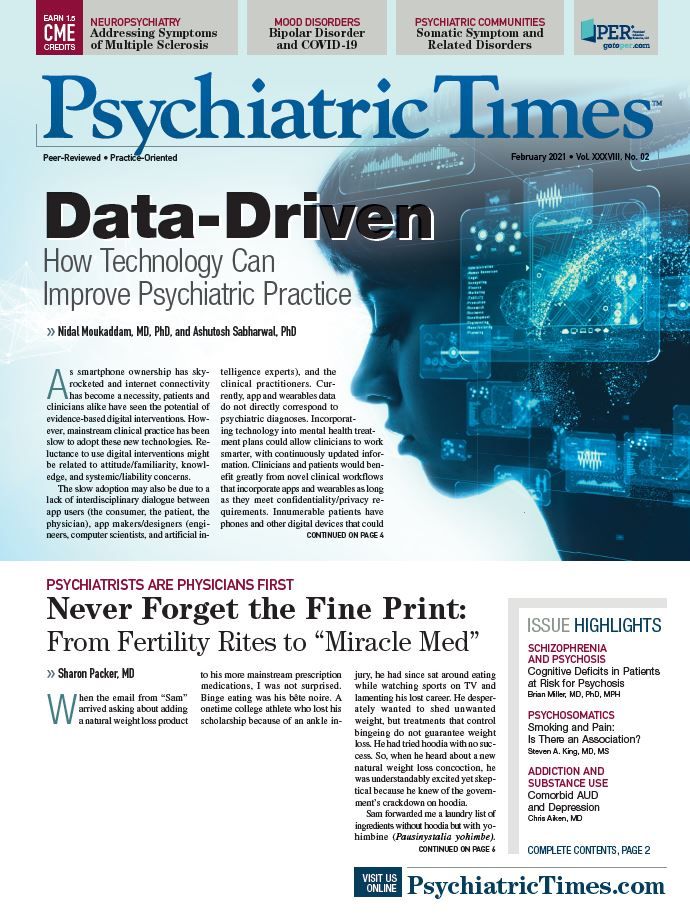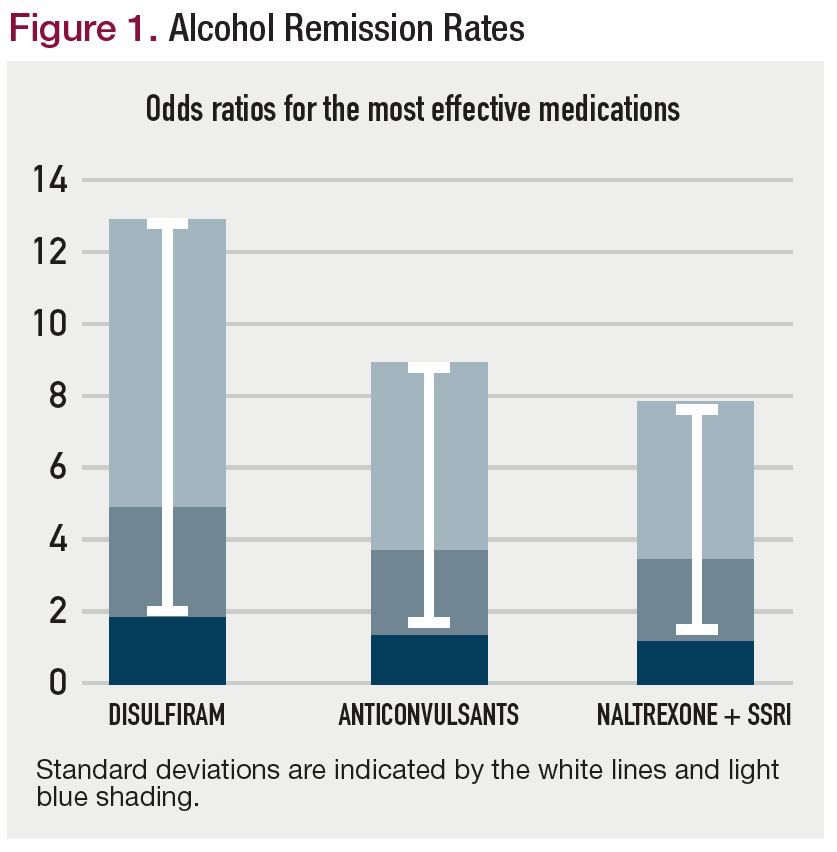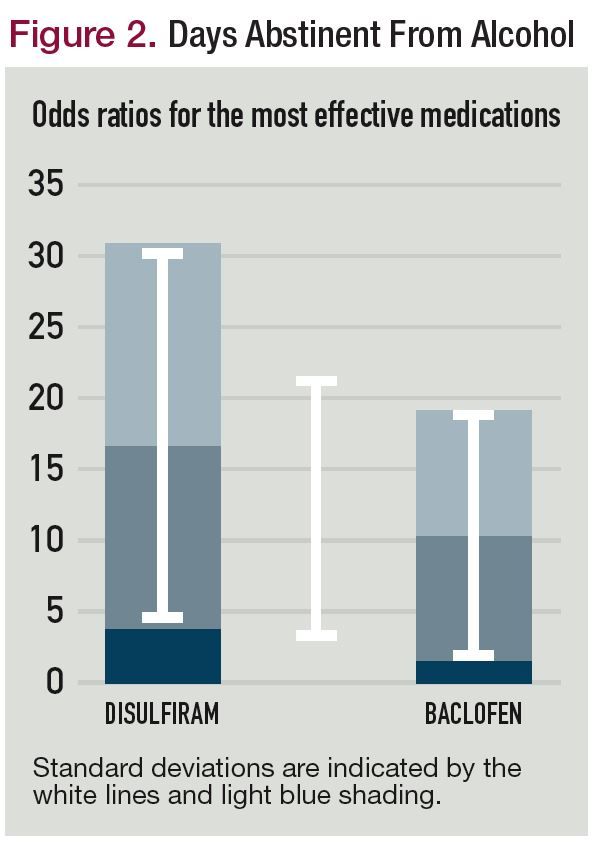Publication
Article
Psychiatric Times
Underused Medication May Be Best Bet for Comorbid AUD and Depression
Author(s):
Despite alcohol-related fatalities soaring to the No. 1 cause of death in middle-aged adults, this medication is often overlooked.
Aleksey159/AdobeStock

CLINICAL
In a network meta-analysis of alcohol use disorders (AUD) with depression, one medication stood out as the most effective but is not widely used. The meta-analysis, which included 66 randomized controlled trials that tested 18 categories of medications in 5890 patients who had an AUD and either major depression or depressive symptoms, found that disulfiram was the most effective at reducing alcohol use across all comparisons.1
Only 3 medications reached statistical significance for remission: disulfiram, anticonvulsants (carbamazepine, topiramate, tiagabine), and a naltrexone with a selective serotonin reuptake inhibitor (Figure 1). The odds ratio for remission was much higher with disulfiram, although the spread of the data was also wider as indicated by the standard deviations in the graph. This difference held up to sensitivity analysis, in which studies that might have skewed the results were removed.
For abstinence, only disulfiram and baclofen reached statistical significance. (Baclofen is a muscle relaxant with mixed results in AUD when studied independent of depression. It has no measurable reinforcing properties; there have been rare reports of baclofen abuse.) The odds ratio for days abstinent was higher for disulfiram compared with baclofen; this finding held up to sensitivity analysis (Figure 2).
For change in depressive symptoms, there were no clear winners. The noradrenergic medications appeared effective as a group, but this group included only venlafaxine and the non-US medication viloxazine. Nearly all efficacy was attributable to viloxazine, a norepinephrine reuptake inhibitor. Mirtazapine showed promise, but only in a secondary analysis of studies looking at full episodes of depression, rather than subsyndromal cases.
Although these studies cannot explain why disulfiram works well in depression, I will venture a guess from clinical experience. Patients with depression are often unable to take action on the things that are good for them, ie, bathing, eating healthy, and achieving sobriety. Although they want to stop drinking, they struggle with ruminative thoughts and never arrive at an executable plan. Disulfiram halts indecision, relieving them of the struggle. Patients are unlikely to drink on disulfiram because their actions are driven more by anxious avoidance than by impulse.
Disulfiram’s efficacy may not be unique to depression. The drug worked well in general AUD in prior analyses. In the 1930s, workers who were exposed to it at a rubber factory became sick after drinking alcohol. This led to the first clinical use in the 1940s and its FDA approval for alcohol cessation in 1951. However, only 200,000 individuals— about 1% of patients with AUD — take disulfiram in the US.
The reason for disulfiram’s decline may be due to its unique mechanism. Disulfiram induces an immediate hangover reaction when combined with alcohol. It blocks the enzyme that metabolizes acetaldehyde, the toxin responsible for alcohol’s hangover effect. With heavy drinking or high doses of disulfiram, this effect can be fatal. When disulfiram was first released, that effect was thought to be necessary, so patients were advised to drink. That practice ended when a few patients died, but it also left a stain on disulfiram’s reputation.
Oncologists do not withhold lifesaving medications because they are potentially toxic. Yet disulfiram appears underutilized, despite the fact that alcohol-related fatalities have soared to the No. 1 cause of death in middle-aged adults. Although fatalities are extremely rare with disulfiram, physicians may feel a greater weight of responsibility for those deaths than they do when patients die from alcohol. An oncologist, however, would not feel this way when a patient dies from cancer.
As a review of disulfiram’s safety noted, “Deaths from the disulfiram-alcohol (ethanol) interaction have not been reported in recent years, possibly because the dosages used are lower than those used 40 years ago and patients with cardiac disease are now excluded from treatment.”2
Today, most physicians prefer the lower dose of 250 mg/day. This produces a less toxic interaction with alcohol and works just as well as 500 mg/day. Actually, placebo worked just as well as disulfiram in the blinded studies because simply warning a patient that the interaction is toxic will help them achieve sobriety even when the pill is a placebo.
Patients must be alcohol free for 12 hours before starting disulfiram; the disulfiram-alcohol interaction persists for up to 2 weeks after stopping disulfiram. Disulfiram is contraindicated in severe coronary artery disease or heart failure, as there have been cases of sudden death after drug initiation. Relative contraindications include liver disease (disulfiram can elevate liver function tests, as can naltrexone), psychotic disorder (there are rare cases of psychosis or confusional states), and active alcohol use (in the past 12 hours). When used in absence of alcohol, common adverse effects include fatigue and headache. Check for drug interactions in the cytochrome P450 enzyme system before starting it.
The bottom line seems pretty straightforward: Don’t overlook disulfiram, but know how to use it safely in AUD.
Dr Aiken is an instructor in clinical psychiatry at the Wake Forest School of Medicine and the director of the Mood Treatment Center in Winston-Salem, North Carolina. He is editor in chief of The Carlat Psychiatry Report and coeditor of the bipolar disorder section for Psychiatric TimesTM.
References
1. Li J, Wang H, Li M, et al. Efficacy of pharmacotherapeutics for patients comorbid with alcohol use disorders and depressive symptoms-a bayesian network meta-analysis. CNS Neurosci Ther. 2020;26(11):1185-1197.
2. Chick J. Safety issues concerning the use of disulfiram in treating alcohol dependence. Drug Saf. 1999;20(5):427-435. ❒









